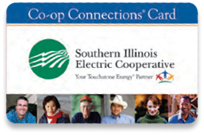 Years ago, there lived a man named Joseph C. McCormick, who by trade was a farmer, although in later years he became a rural mail carrier. Less than a hundred yards from his home in rurual Olmsted, Illinois, in Pulaski County, there stretched a transmission line of a private power company. Mr. McCormick thought it would be great if this utility would service the people just a little bit further outside the limits of Olmsted. He was thinking of all the good things of modern day that he and his neighbors could enjoy. Imagine…electric lights, electric washing machines, electric irons, and even electric refrigerators.
Years ago, there lived a man named Joseph C. McCormick, who by trade was a farmer, although in later years he became a rural mail carrier. Less than a hundred yards from his home in rurual Olmsted, Illinois, in Pulaski County, there stretched a transmission line of a private power company. Mr. McCormick thought it would be great if this utility would service the people just a little bit further outside the limits of Olmsted. He was thinking of all the good things of modern day that he and his neighbors could enjoy. Imagine…electric lights, electric washing machines, electric irons, and even electric refrigerators.
The officials of the power company were sympathetic. They agreed it would be entirely possible to build a five-mile loop to service 24 families within its area. It looked promising until the utility officials informed it would cost each family on this loop about $300 annually for electric service. That amount was out of the question.
A persistent man, Mr. McCormick kept alive the spark of hope as far as electric service was concerned. He called on neighbors to volunteer to canvass the region for interested parties. The volunteers signed many people who really wanted electricity, but at a more reasonable price than the utility was demanding. In 1938, farm publications and newspapers printed articles describing the growth of rural electric cooperatives in other parts of Illinois.
On a recommendation of a Pulaski County farm advisor, Mr. McCormick arranged for a meeting with an expert from the Rural Electrification Administration (REA). He was told that his group was too small for REA assistance and that they would need more people interested in the project. So after getting delegates from each county, an organizational meeting was held to discuss the problems associated with getting electricity. They knew they had a big job facing them but figured that if cooperatives could be established elsewhere, one could be established in southern Illinois.
Thus, Southern Illinois Electric Cooperative was formed and nine directors were elected and with the proceeds of a $200,000 REA loan, construction was possible for the first section of line. The culmination of the project came in May 1939, when the lights were turned on for the first time.


